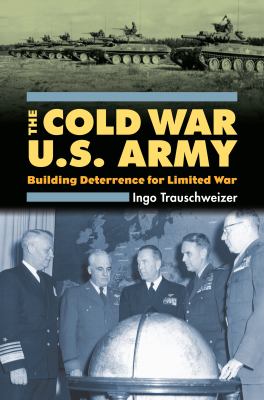
|
The Cold War U.S. Army : building deterrence for limited war
Copies
0 Total copies, 0 Copies are in,
0 Copies are out.
Title
The Cold War U.S. Army : building deterrence for limited war
Call No
UA26.E9
Authors
Subjects
United States. Army, Europe and Seventh Army--History.
United States. Armed Forces--Europe--History.
United States. Army, Europe and Seventh Army--History. (DLC)n 81035086
United States.--Army--Europe and Seventh Army--History. (DLC)n 78095330
United States.--Armed Forces--Europe--History. (DLC)n 78095330
USA Militär. idszbz. (local)tlcaut2660795908000
United States. Army, Europe and Seventh Army. (OCoLC)fst00555440 fast. (local)tlcaut2660842433900
United States. Army. Europe and Seventh Army--History.
Cold War (1945-1989) (OCoLC)fst01754978 fast. (local)tlcaut2640153978800
Operational art (Military science)--History--20th century.
Deterrence (Strategy)
Cold War.
Operational art (Military science)--History--20th century.
Deterrence (Strategy)
Cold War.
Kalter Krieg--Kriegswissenschaft--USA.
Kriegswissenschaft--Kalter Krieg--USA.
Abschreckung.
Heer--USA--Geschichte 1945-2000.
Truppenstationierung--USA--Deutschland (BRD)--Geschichte 1949-2000.
Verteidigung--Europa--Geschichte 1945-2000.
Organisation.
Ost-West-Konflikt.
Abschreckung.
Abschreckung.
Militär.
Organisation.
Ost-West-Konflikt.
Armed Forces.
Deterrence (Strategy)
Operational art (Military science)
Strategic aspects of individual places.
Europe--Strategic aspects.
United States--Armed Forces--Europe--History.
Europe--Strategic aspects.
United States.
Europe.
United States.
United States--Armed Forces--Europe--History.
History.
United States. Armed Forces--Europe--History.
United States. Army, Europe and Seventh Army--History. (DLC)n 81035086
United States.--Army--Europe and Seventh Army--History. (DLC)n 78095330
United States.--Armed Forces--Europe--History. (DLC)n 78095330
USA Militär. idszbz. (local)tlcaut2660795908000
United States. Army, Europe and Seventh Army. (OCoLC)fst00555440 fast. (local)tlcaut2660842433900
United States. Army. Europe and Seventh Army--History.
Cold War (1945-1989) (OCoLC)fst01754978 fast. (local)tlcaut2640153978800
Operational art (Military science)--History--20th century.
Deterrence (Strategy)
Cold War.
Operational art (Military science)--History--20th century.
Deterrence (Strategy)
Cold War.
Kalter Krieg--Kriegswissenschaft--USA.
Kriegswissenschaft--Kalter Krieg--USA.
Abschreckung.
Heer--USA--Geschichte 1945-2000.
Truppenstationierung--USA--Deutschland (BRD)--Geschichte 1949-2000.
Verteidigung--Europa--Geschichte 1945-2000.
Organisation.
Ost-West-Konflikt.
Abschreckung.
Abschreckung.
Militär.
Organisation.
Ost-West-Konflikt.
Armed Forces.
Deterrence (Strategy)
Operational art (Military science)
Strategic aspects of individual places.
Europe--Strategic aspects.
United States--Armed Forces--Europe--History.
Europe--Strategic aspects.
United States.
Europe.
United States.
United States--Armed Forces--Europe--History.
History.
Language
English
Published
Lawrence, Kan. : University Press of Kansas, ©2008.
Publication Desc
xii, 366 p. : ill., maps ;
ISBN
9780700615780
(cloth : alk. paper)
LCCN
2008003947
Target Audience
Unknown or not specified
Dimensions
24 cm.









